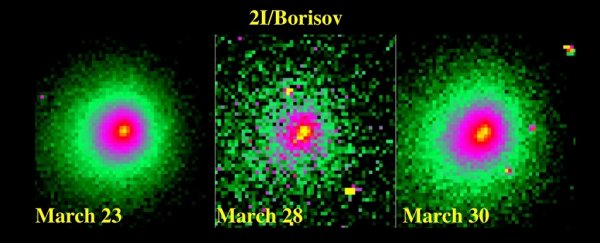Welp, that's clinched it. It seems like it really is the end of the road for 2I/Borisov, a comet that travelled light-years across space before winding up in the Solar System. New data show that the comet is coming apart.
The most recent Hubble observations of the comet suggest that the comet has broken into at least two pieces, according to a notice posted to Astronomer's Telegram.
"Images from UT 2020 March 23 show a single inner brightness core, like that observed in all previous HST images of 2I/Borisov," wrote a team of astronomers led by David Jewitt of the University of California Los Angeles.
"In contrast, images from UT 2020 March 30 show a clearly non-stellar core, consistent with two unresolved components separated by 0.1 arcsecond (180 km at the distance of the comet) and aligned with the main axis of the larger dust coma."
This is not at all an unexpected turn of events. Astronomers have been avidly watching the comet following its closest approach to the Sun, or perihelion, on 8 December 2019.
It's pretty normal for comets to break up as they reach and pass perihelion. What we think happens has to do with outgassing, due to the sublimation of cometary ices as they are heated by the Sun. This is thought to spin up the comet's nucleus, causing it to fragment under centripetal instability.
Not all comets come apart like this, so astronomers were watching and waiting to see whether 2I/Borisov - a comet discovered in August last year, with a trajectory indicating that it came from outside the Solar System - would continue on its way, or come to the end its long journey right here.
And sure enough, last month, it seemed the latter was the case. A team of Polish astronomers led by Michal Drahus and Piotr Guzik of Jagiellonian University noticed that, in early March, the comet brightened significantly, twice in a few days. This behaviour, they said, was "strongly indicative of an ongoing nucleus fragmentation."
According to these new observations, as of at least March 28, the comet is now in bits.
"The double appearance, indicating the ejection of a nucleus fragment, is confirmed in HST data from UT 2020 March 28," Jewitt's team wrote.
This process may seem like sad news for 2I/Borisov, but it's an amazing opportunity for astronomers. As the comet fragments further, we can take images of its spectrum to figure out what it's made of, and how similar or different it is from Solar System comets.
So far, observations have found that the comet's colour and composition are, in fact, very similar to comets from the outer limits of the Solar System. This is exciting because it's thought that Solar System comets could have carried a bunch of the ingredients for life to Earth. If 2I/Borisov is similar to those comets, it hints that comets could have carried such ingredients to other worlds, too.
Astronomers are definitely going to be keeping an eye on 2I/Borisov, and more Hubble observations have been planned to make sure we catch as much of its ongoing fragmentation as possible.
